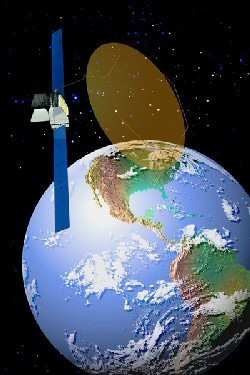Billions Spent For No Result, Program Cancelled
 A colossal and expensive
bungle over spy satellites that cost the US billions, described by
one analyst as a "train wreck," would appear to be a record of how
not to build intelligence technology group.
A colossal and expensive
bungle over spy satellites that cost the US billions, described by
one analyst as a "train wreck," would appear to be a record of how
not to build intelligence technology group.
A government project called Future Imagery Architecture was
running $2-3 billion over budget that triggered a panel to
investigate the project in 2002, according to the New York
Times.
The panel reported from records at the National Reconnaissance
Office, and suggested to continue on with the projects shortly
after the September 11 attacks.
With the new satellites promising improved, more frequent images
of foreign threats like terrorist training camps, nuclear weapons
plants and enemy military maneuvers, they advised Peter B. Teets,
head of the nation’s spy satellite agency to obtain an
infusion of $700 million. This was just another band-aid for a
project that failed.
After two years, several review panels and billions more dollars
the government finally killed the project -- perhaps the most
spectacular and expensive failure in the 50-year history of
American spy satellite projects.
But an investigation by the Times found that the collapse of the
project, at a loss of at least $4 billion, was all but inevitable
-- the result of a troubled partnership between a government
seeking to maintain the supremacy of its intelligence technology,
but on a constrained budget, and a contractor all-too willing to
make promises it ultimately could not keep.
"The train wreck was predetermined on Day 1," said Thomas Young,
a former aerospace executive who led a panel that examined the
project.
The Times' investigation found the satellite agency put the
Future Imagery contract out for bid in 1998, despite an internal
assessment that questioned whether its lofty technological goals
were attainable given the tight budget and schedule.
Boeing had never built the kind of spy satellites the government
was seeking, but told Congress it could live within the stringent
spending caps imposed by Congress and the satellite agency. The
government, in turn, accepted the company's optimistic projections.
Despite its relative inexperience, Boeing was given responsibility
for monitoring its own work, under a new government policy of
shifting control of big military projects to contractors.
According to the Times, the satellite agency, at the same time
hobbled by budget cuts and the loss of seasoned staff members,
lacked the expertise to make sound engineering determinations of
its own. The satellites were loaded with intelligence collection
requirements, as numerous intelligence and military services
competed to influence their design.
Boeing’s engineers said that the designs were so
complicated and elaborate that they said they could not be built.
Engineers constructing a radar-imaging unit could not initially
produce the unusually strong radar signal as designed.
A gaggle of defective parts, like gyroscopes and electric
cables, repeatedly shut down operations. Even what is described as
an elementary rule of spacecraft construction -- never use tin,
because it deforms in space and can short-circuit electronic
components -- was ignored by parts suppliers.
 Ironically when the
satellite known as F.I.A. was to have been delivered the project
was killed, with over runs as high as $18 billion.
Ironically when the
satellite known as F.I.A. was to have been delivered the project
was killed, with over runs as high as $18 billion.
"The F.I.A. contract was technically flawed and unexecutable the
day it was signed," said Robert J. Hermann, who ran the National
Reconnaissance Office from 1979 to 1981. Hermann also led the panel
in 1996 that first recommended creation of a new satellite system.
"Some top official should have thrown his badge on the table and
screamed, ‘We can’t do this system at this
price.’ No one did."
Boeing's go-to man, Ed Nowinski, was an engineer who had become
a top government spy satellite expert during 28 years at the
Central Intelligence Agency was in charge of the project.
Nowinski acknowledged that Boeing frequently provided the
government with positive reports on the troubled project.
"Look, we did report problems," Nowinski said, "but it was
certainly in my best interests to be very optimistic about what we
could do."
Boeing eventually fired Nowinski as the project fell apart. A
Boeing spokeswoman, Diana Ball, said the company could not discuss
classified programs.
 ANN's Daily Aero-Linx (04.13.24)
ANN's Daily Aero-Linx (04.13.24) ANN's Daily Aero-Term (04.13.24): Beyond Visual Line Of Sight (BVLOS)
ANN's Daily Aero-Term (04.13.24): Beyond Visual Line Of Sight (BVLOS) Airborne 04.09.24: SnF24!, Piper-DeltaHawk!, Fisher Update, Junkers
Airborne 04.09.24: SnF24!, Piper-DeltaHawk!, Fisher Update, Junkers Aero-News: Quote of the Day (04.14.24)
Aero-News: Quote of the Day (04.14.24) ANN's Daily Aero-Term (04.14.24): Maximum Authorized Altitude
ANN's Daily Aero-Term (04.14.24): Maximum Authorized Altitude




